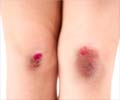Researchers at Ohio State University, led by an Indian-origin scientist, have developed a mathematical model of chronic wound healing that could do away with guesswork and clearly
A mathematical model of chronic wound healing, developed by researchers at the Ohio State University and led by an Indian-origin scientist, could possibly eliminate all guesswork and clearly suggest treatment strategies towards tackling this major public-health problem.
The researchers are the first to publish a mathematical model of an ischemic wound - a chronic wound that heals slowly or is in danger of never healing because it is fed by an inadequate blood supply.Ischemic wounds are a common complication of diabetes, high blood pressure, obesity and other conditions that can be characterized by poor vascular health.
The wound model reduces the need for guesswork and time-consuming animal testing traditionally required as researchers pursue prevention, diagnosis and treatment of complex diseases.
"Before you treat any problem successfully, you have to understand it. Now that we have this model, we can take the next step to find what factors in the equations can be fine-tuned to the point where the net result is improvement in the ischemic wound outcome," said Chandan Sen.
The mathematical model, to date, simulates both non-ischemic wounds - those typical of wounds in healthy people with good circulation - and ischemic wounds.
The current model produced results that generally match pre-clinical expectations- that a normal wound will close in about 13 days, and that 20 days after the development of an ischemic wound, only 25 percent of the wound will be healed.
In a recent study, Sen designed a biological pre-clinical model of an ischemic wound using the skin on a pig's back.
The study has been published in the online early edition of the Proceedings of the National Academy of Sciences.
Source-ANI
TAN
 MEDINDIA
MEDINDIA



 Email
Email







